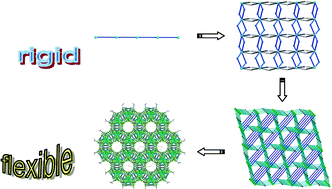Synthesis, structures and properties of nickel(ii) and cobalt(ii) metal–organic frameworks based on a flexible tricarboxylate ligand H3TTG and different pyridyl-containing ligands†
Abstract
Along with our recent investigations on Ni and Co coordination frameworks of a flexible tripodal ligand of H3TTG (N,N′,N″-1,3,5-triazine-2,4,6-triyltris-glycine), four new complexes {[Ni(HTTG)(4,4′-bpy)(H2O)3]·(H2O)2}n (1), {[Ni2(HTTG)2(bpe)2(H2O)]·(H2O)6}n (2), {[Co2(HTTG)2(bpe)2(H2O)]·(H2O)6}n (3) and {[Co3(TTG)2(bpe)2]·(H2O)2}n (4) were hydrothermally synthesized through reactions of this ligand with different pyridyl-containing ligands {4,4′-bpy (4,4-bipyridine), bpe [1,2-bi(4-pyridyl)ethane]}, respectively. Due to various coordination modes and conformations of the flexible tricarboxylate ligand and pyridyl-containing coligands, these complexes exhibit structural and dimensional diversity. Complex 1 shows a unique 1D chain bridged by the R22(8) hydrogen bonds between the carboxylate groups, the triazine rings, and hydrogen-bonded networks of the solvent water molecules as well. Complexes 2 and 3 are isomorphous and both exhibit special 2D (8,2)-connected double-layer structures with two kinds of 1D channels constructed by the coordination bonds and hydrogen bonding interactions, respectively. Complex 4 features a 3-D network with scarce (8,3)-connected rutile-related topology with a Schläfli symbol (42,622,7,83)(4,62)2 based on secondary building units (SBUs) of linear cobalt clusters [Co3(CO2)4]2−. Significantly, with increasing flexibility of the pyridyl-containing coligands, these corresponding complexes become more and more complicated. In addition, their physical properties such as thermal, XPRD, and magnetism have also been investigated.


 Please wait while we load your content...
Please wait while we load your content...